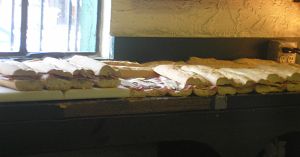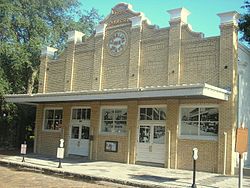- Cuban bread
-
Cuban bread is a fairly simple white bread, similar to French bread and Italian bread, but has a slightly different baking method and ingredient list (in particular, it generally includes a small amount of fat in the form of lard or vegetable shortening); it is usually made in long, baguette-like loaves. It is a staple of Cuban-American cuisine and is traditionally the bread of choice when making an authentic Cuban sandwich.
Contents
History
There is some debate about the true source of "real" Cuban bread, with both Miami and Tampa, Florida claiming to be the home of the best. With regards to where it originated, the earliest U.S. bakery to produce Cuban bread was most likely La Joven Francesca Bakery[1], which was established in 1896 by the Sicilian-born Francisco Ferlita in Ybor City, a Cuban-Spanish-Italian immigrant community in Tampa. This bakery sold bread for 3 to 5 cents a loaf, mainly to the Ybor City market.[2]
The bakery was destroyed by fire in 1922, leaving only the brick bread oven standing. Francisco rebuilt the bakery even larger than before, adding a second oven, and it became a major supplier of bread for the Tampa/Ybor area. The bakery also became a place to congregate, drink a good cup of Cuban coffee, and catch up on the local news.[3]
In Ybor City, bread used to be delivered every morning like milk. Houses had a sturdy nail driven into the doorframe next to the door. The bread deliveryman would impale the fresh loaf of bread on the nail.[4]
La Joven closed in 1973,[2] but soon found new life when it was renovated and converted into the Ybor City State Museum, becoming the main part of the museum complex. The original ovens where the original Cuban bread was baked are still viewable inside.[5]
La Segunda Bakery ('The Second' as La Primera, 'The First,' burned down long ago) is currently the major producer of Cuban Bread for the Tampa area. It was founded by Juan Morè, who migrated to Tampa, FL, and opened La Primera Bakery in 1915.[6]
Characteristics
It is not amiss to say that the Latins in Ybor City make a very fine bread, equal in all respects to the French article of that kind and unexcelled by the Vienna product. -Tampa Daily Journal, 1896 [7]
A traditional loaf of Cuban bread is approximately three feet long and somewhat rectangular crossways (as compared to the rounder shape of Italian or French bread loaves). It has a hard, thin, almost papery toasted crust and a soft flaky middle.[8] In the early days, the dough was stretched thin to make it last, creating the bread's distinctive air pockets and long shape. As they have for decades, La Segunda and other traditional Cuban bread makers lay a long, moist palm frond on top of the loaves before baking, creating a shallow trench in the upper crust, producing an effect similar to the slashing of a European-style loaf. (The frond is removed before eating.)
Cuban bread is the necessary base for a 'Cuban sandwich' (sometimes called a "sandwich mixto").[9][10][11] It can also be served as a simple breakfast, especially toasted and pressed with butter and served alongside (and perhaps dunked into) a hot mug of cafe con leche (strong dark-roasted Cuban coffee with scalded milk).
Cuban bread should be eaten soon after baking, as it tends to go stale quickly. (In Ybor City, it was said that after 24 hours, Cuban bread is only good for breading a deviled crab.) It can also be frozen.
Stale Cuban bread is the preferred "weapon of choice" in protests performed by the Conch Republic.
References
- ^ "That Cuban beat presses on". Herald Tribune. 2009-10-21. http://www.heraldtribune.com/article/20091021/article/910211001. Retrieved 2010-09-03.
- ^ a b "Historical Marker". Waymarking.com. http://www.waymarking.com/gallery/image.aspx?f=1&guid=9e5ac378-0a8b-4ac9-a7fe-a69902022e83&gid=3. Retrieved 2008-12-22.
- ^ "Citytimes: For 65 years, he brought Cuban bread all over town". Sptimes.com. http://www.sptimes.com/2003/11/28/Citytimes/For_65_years__he_brou.shtml. Retrieved 2008-12-22.
- ^ "Cuban Is Ours, Any Way You Try To Slice It". Tbo.com. October 24, 2007. http://www.tbo.com/news/metro/MGBQAS0758F.html. Retrieved 2008-12-22.[dead link]
- ^ "Museum | Ybor City Museum". Ybormuseum.org. http://www.ybormuseum.org/museum/index.html. Retrieved 2008-12-22.[dead link]
- ^ "Cuban Food and Latin Food Restaurants: La Segunda Central Bakery, Tampa, FL". Cuban-food-usa.com. http://cuban-food-usa.com/tampa_la_segunda.html. Retrieved 2008-12-22.
- ^ Ingalls, Roberts and Louis Perez, Jr. Tampa Cigar Workers. 2003. University Press of Florida, p. 49.
- ^ "Cuban Bread: A History". Bread-maker.net. http://www.bread-maker.net/Bread-Types/Cuban-Bread.htm. Retrieved 2008-12-22.
- ^ Linda Stradley. "Cuban Sandwich, History of Cuban Sandwich, History of Cubano Sandwich". Whatscookingamerica.net. http://whatscookingamerica.net/History/Sandwiches/CubanSandwich.htm. Retrieved 2008-12-22.
- ^ "Floridian: The search for the perfect Cuban sandwich". Sptimes.com. http://www.sptimes.com/2006/12/05/Floridian/The_search_for_the_pe.shtml. Retrieved 2008-12-22.
- ^ "Cuban Sandwich | Tampa Bay's Cigar City Magazine". Cigarcitymagazine.com. http://www.cigarcitymagazine.com/features/cuban-sandwich.html. Retrieved 2008-12-22.
External links
- Cuban Bread Recipe (uses the sponge method)
- commercial Cuban bread recipe from La Segunda Bakery in Tampa, Florida (uses the direct-yeast method)
American breads Amish Friendship Bread · Anadama bread · Banana bread · Bannock (food) · Beaten biscuit · Biscuit (bread) · Bulkie roll · Cornbread · Cuban bread · Frybread · Hot water corn bread · Hushpuppy · Kaiser roll · Muffin · Muffin (English) · Muffuletta · Parker House roll · Pepperoni roll · Popover · Pullman loaf · Shawnee cake · Sloosh · Texas toast
 Recipes on WikiBooks ·
Recipes on WikiBooks ·  Category:American breads ·
Category:American breads ·  The Food Portal ·
The Food Portal ·  The United States PortalCategories:
The United States PortalCategories:- Cuban cuisine
- American breads
- Culture of Tampa, Florida
Wikimedia Foundation. 2010.



